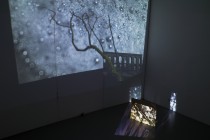
Non-representation theory is a theory initiated in 1960 with Optical Arts, and developed further in 2000s. Instead of studying what is represented, non-representation theory focuses on practices – how human and human body can communicate through gestures or other means. It studies what is gained through experiences – before they are represented as images.
Considering the role that images have played, the history of Arts in the west is equivalent to that of representation. Images have been produced over years as tools to represent myth, doctrines of religions, and communicated its meaning to by those who are eager for the power or looking for salvation.
On contrary, thinking about the role of images in Japan, instead of symbolizing, representing something, or implying meaning, they functioned well as rich, deep and varying kinds of patterns, which transformed things that cannot be perceived per se to something visible – nature and varying seasons of the year. A good example is Japanese Kimono. Kimono were never seen as public images, nor discussed in the context of Arts – rather, they have been treated as something that is consumed by individuals.
Can’t we treat this Japanese sense of images as images that publically functions? Representational images always go along well with authority. Contrary to that, this Japanese sense – what I call non-representation – always comes back to individuals. Each individual practices the sense (not restricted to artistic sense) and strives hard. This practice includes both sides, receiving – object and expressing – subject. It requires the exactness – almost the same level of it as that is required for mathematics. When this personal practice is submitted to an Arts community, this image is non-representational yet possible to play the public function. This also leads to an attempt for an individual to co-exist with the economics that is based on capital (exploited and exploitation of experiences by mass-production/mass-consumption).
Takashi Murakami called this Japanese sense *super flat* and established his success by creating paintings and sculptures with images from Japanese anime (cartoons) and taking them to the traditional art society. I call it non-repesentation, and using “Ka-cho-fu-getsu” (literally translated as flowers, birds, wind and moon – meaning nature and the changing season over the year) as a motif, and offer it in the form of installation in the context of arts.
